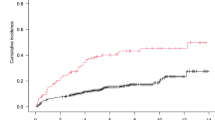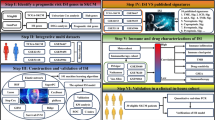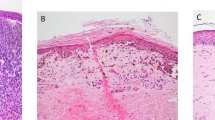Abstract
Serum soluble interleukin-2 receptor (sIL-2R), intercellular adhesion molecule-1 (sICAM-1) and interleukin-10 (IL-10) have each been reported as useful markers for melanoma progression. To evaluate the clinical relevance of these three markers, we simultaneously analysed their serum levels in patients with melanoma. A longitudinal study with a 3-year follow-up was performed and different stages of the disease were considered. Mean values of sIL-2R were significantly higher than in normal controls in all stages and correlated with the disease progression. The prognosis of patients with levels > 529 U/ml of sIL-2R was significantly poorer than in patients with sIL-2R levels < 529 U/ml. Levels of sICAM-1 were also elevated in melanoma patients, specially at the time of the metastatic disease. Serum IL-10 levels were more frequently detectable in the patients that developed metastasis during follow-up, and the prognosis of patients with detectable IL-10 levels was significantly poorer than in those patients with IL-10 undetected levels. Statistical analysis based on Logistic and Cox regression models showed that only sex, stage and sIL-2R value are factors significantly associated with metastatic progression. Moreover, high levels of sIL-2R could be a risk factor for malignant progression in melanoma. © 2000 Cancer Research Campaign
Similar content being viewed by others
Article PDF
Change history
16 November 2011
This paper was modified 12 months after initial publication to switch to Creative Commons licence terms, as noted at publication
References
Alileche A, Plaisance S, Han DS, Rubinstein E, Mingari C, Bellomo R, Jasmin C and Azzarone B (1993) Human melanoma cell line M14 secretes a functional interleukin 2. Oncogene 8: 1791–1796
Altamonte M, Colizzi F, Esposito G and Maio M (1991) Circulating intercellular adhesion molecule-1 as a marker of disease progression in cutaneous melanoma. N Engl J Med 327: 959–962
Banks RE, Gearing AJH, Hemingway IK, Norfolk DR, Perren TJ and Selby PJ (1993) Circulating intercellular adhesion molecule-1 (ICAM-1), E-selectin and vascular cell-adhesion molecule-1 (VCAM-1) in human malignancies. Br Cancer Res 68: 122–124
Becker JC, Dummer R, Hartmann AA, Burg G and Schmidt RE (1991) Shedding of ICAM-1 from human melanoma cell lines induced by IFN-γ and tumour necrosis factor-α. J Immunol 147: 4398–4401
Boyano MD, García-Vázquez MD, Gardeazabal J, García de Galdeano A, Smith-Zubiaga I, Cañavate ML, Ratón JA, Bilbao I and Díaz-Pérez JL (1997) Serum-soluble IL-2 receptor and IL-6 levels in patients with melanoma. Oncology 54: 400–406
Burton J, Goldman CK, Rao P, Moos M and Waldmann TA (1990) Association of intercellular adhesion molecule 1 with the multichain high-affinity interleukin-2 receptor. Proc Natl Acad Sci USA 78: 7329–7333
Chen Q, Daniel V, Maher DW and Hersey P (1994) Production of IL-10 by melanoma cells: examination of its role in immunosuppression mediated by melanoma. Int J Cancer 56: 755–760
Dummer W, Becker JC, Achwaaf A, Leverkus M, Moll T and Brocker EB (1995) Elevated serum levels of interleukin-10 in patients with metastatic malignant melanoma. Melanoma Res 5: 67–68
Fernandez-Botran R (1991) Soluble cytokine receptors: their role in immuneregulation. FASEB J 5: 2567–2574
Fierro MT, Lisa F, Novelli M, Beretero M and Bernengo MG (1992) Soluble Interleukin-2 receptor, CD4 and CD8 levels in melanoma: A longitudinal study. Dermatology 184: 182–189
Fiorentino DF, Zlotnik A, Mosmann TR, Howard M and O'Garra A (1991a) IL-10 inhibits cytokine production by activated macrophages. J Immunol 147: 3815–3822
Fiorentino DF, Zlotnik A, Vieira P, Mosmann TR, Howard M, Moore KW and O'Garra A (1991b) IL-10 acts on the antigen-presenting cell to inhibit cytokine production by Th1 cells. J Immunol 146: 3444–3451
García de Galdeano A, Boyano MD, Smith-Zubiaga I and Cañavate ML (1996) B16F10 murine melanoma cells express interleukin-2 and a functional interleukin-2 receptor. Tumor Biol 17: 155–167
Giavazzi R, Chirivi RGS, Garafalo A, Rambaldi A, Hemingway I and Pigott R (1992) Soluble intercellular adhesion molecule-1 is released by human melanoma cells and is associated with tumour growth in nude mice. Cancer Res 52: 2628–2630
Harning R, Mainolfi E, Bystryn JC, Henn M, Merluzzi VJ and Rothlein R (1990) Serum levels of circulating intercellular adhesion molecule-1 in human malignant melanoma. Cancer Res 51: 5003–5005
Howard M, O'Garra A, Ishida H, de Waal MR and de Vries J (1992) Biological properties of Interleukin-2. J Clin Immunol 12: 239–247
Huang S, Xie K, Bucana CD, Ullrich SE and Bar-Eli M (1996) Interleukin 10 suppresses tumour growth and metastasis of human melanoma cells: potential inhibition of angiogenesis. Clin Cancer Res 2: 1969–1979
Johnson JP, Stade BG, Holtzmann B, Schwable W and Riethmuller G (1989) De novo expression of intercellular adhesion molecule 1 in melanomas correlates with increased risk of metastasis. Proc Natl Acad Sci USA 86: 641–644
Josimovic-Alasevic O, Herrmann T and Diamantstein T (1988) Demonstrations of two distinct forms of released low-affinity type interleukin-2 receptors. Eur J Immunol 18: 1855–1857
Kageshita T, Yoshii A, Kimura N, Ono t, Tsujisaki M, Imai K and Ferrone S (1993) Clinical relevance of ICAM-1 expression in primary lesions and serum of patients with malignant melanoma. Cancer Res 53: 4927–4932
Kerbel RS (1992) Expression of multi-cytokine resistance and multigrowth factor independence in advanced stage metastatic cancer. Am J Pathol 141: 519–524
Landáyi A, Nagy JO, Jeney A and Tímar J (1998) Cytokine sensitivity of metastatic human melanoma cells lines- simultaneous inhibition of proliferation and enhancement of gelatinase activity. Pathology Oncology Res 2: 108–114
Marlin SD and Springer TA (1987) Intecellular adhesion molecule-1 (ICAM-1) is a ligand for lymphocyte function-associated antigen-1 (LFA-1). Cell 15: 831–843
Natali P, Nicotra MR, Cavalieri R, Bigotti A, Romano G, Temponi M and Ferrone S (1990) Differential expression of intercellulat adhesion molecule 1 in primary and metastatic melanoma lesions. Cancer 50: 1271–1278
Plaisance S, Rubinstein E, Alileche A, Han DS, Sahraoui Y, Mingari C, Bellomo R, Rimoldi D, Colombo MP and Jasmin C (1993) Human melanoma cells express a functional interleukin-2 receptor. Int J Cancer 55: 164–170
Rubin LA and Nelson DL (1990) The soluble interleukin-2 receptor: Biology, function and clinical application. Ann Inter Med 113: 619–627
Sato T, McCue P, Masuoka K, Salwen S, Lattime EC, Mastrangelo MJ and Berd D (1916) Interleukin 10 production by human melanoma. Clin Cancer Res 2: 1383–1390
Schadendorf D, Diehl S, Zuberbier T, Schadendorf C and Henz BM (1996) Quantitative detection of soluble adhesion molecules in sera of melanoma patients correlates with clinical stage. Dermatology 192: 89–93
Staunton DE, Daustin ML, Erickson HP and Springer TA (1990) The arrangement of the immunoglobulin-like domains of ICAM-1 and the binding sites for LFA-1. Cell 61: 243–254
Taga K and Tosako G (1992) IL-10 inhibits human T cell proliferation and IL-2 production. J Immunol 148: 1143–1147
Timonen T, Patarroyo M and Gahmberg CG (1988) CD11a-c/CD18 and GP84 (LB-2) adhesion molecules on human large granular lymphocytes and their participation in natural killing. J Immunol 141: 1041–1046
Tsujisaki M, Imai K, Hirata H, Hanzawa Y, Masuya J, Nakano T, Sugiyama T, Matsui M, Hinoda Y and Yachi A (1991) Detection of circulating intercellular adhesion molecule-1 antigen in malignant diseases. Clin Exp Immunol 85: 3–8
Vanky F, Wang P, Patarroyo M and Klein E (1990) Expression of the adhesion molecule ICAM-1 and major histocompatibility complex class I antigens on human tumour cells is required for their interaction with autologous lymphocytes in vitro. Cancer Immunol Immunother 31: 19–27
Yue FY, Dummer R, Geertsen R, Hofbauer G, Laine E, Manolio S and Burg G (1997) Interleukin-10 is a growth factor for human melanoma cells and down-regulates HLA class-I, HLA class-II and ICAM-1 molecules. Int J Cancer 71: 630–637
Author information
Authors and Affiliations
Rights and permissions
From twelve months after its original publication, this work is licensed under the Creative Commons Attribution-NonCommercial-Share Alike 3.0 Unported License. To view a copy of this license, visit http://creativecommons.org/licenses/by-nc-sa/3.0/
About this article
Cite this article
Boyano, M., Garcia-Vázquez, M., López-Michelena, T. et al. Soluble interleukin-2 receptor, intercellular adhesion molecule-1 and interleukin-10 serum levels in patients with melanoma. Br J Cancer 83, 847–852 (2000). https://doi.org/10.1054/bjoc.2000.1402
Received:
Revised:
Accepted:
Published:
Issue date:
DOI: https://doi.org/10.1054/bjoc.2000.1402
Keywords
This article is cited by
-
IL-10 contributes to gemcitabine resistance in extranodal NK/T-cell lymphoma cells via ABCC4
Investigational New Drugs (2022)
-
Hsp70-containing extracellular vesicles are capable of activating of adaptive immunity in models of mouse melanoma and colon carcinoma
Scientific Reports (2021)
-
Micro-environmental cross-talk in an organotypic human melanoma-in-skin model directs M2-like monocyte differentiation via IL-10
Cancer Immunology, Immunotherapy (2020)
-
Ascites IL-10 Promotes Ovarian Cancer Cell Migration
Cancer Microenvironment (2018)
-
Anticancer immunotherapy by CTLA-4 blockade: obligatory contribution of IL-2 receptors and negative prognostic impact of soluble CD25
Cell Research (2015)



